Location :
The tradition of Mahakala in minds of the people is eternal Ujjain whic was used to be centre point of the calculation of the Indian time and Mahakala was considered as the distinctive presiding deity of Ujjain. Lord Shiva linga is worshipped throughout India as it symbolises Shiva's incarnate power on earth. On the other hand, a jyotirlinga is the swayamabhu which is self-manifested linga, which is found only in 12 places in India.
Significance of the temple
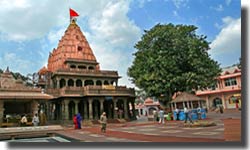
The presiding deity of this temple, Lord Shiva with all his splendour reigns eternal in Ujjain. The temple complex of Mahakaleshwar, with its shikhara soaring into the skies, an imposing façade against the skyline, seriously evokes primordial awe and reverence with its majesty. The Mahakal i.e. Lord Shiva dominates the life of the city and its people. Although even in the midst of the busy routine of modern preoccupations it provides an unbreakable link with past traditions. It is one among the 12 Jyotirlingas in India, the lingam at the Mahakal is believed to be swayambhu - born of it, which derives the currents of power (Shakti) from within itself as against the other images and lingams which are ritually established and invested with mantra-shakti.
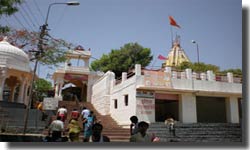
On the occasion of Mahashivaratri, a huge fair is held near the temple, and worship goes on through the night. The Mahakaleshwar temple in Ujjain is located near a lake which has five levels, one of which is underground. The temple here itself is located in a very much spacious courtyard surrounded by massive walls. The shikhara near the temple is adorned with sculptural finery. There are brass lamps which are lit up the way to the underground sanctum. It is believed that prasadam offered here to the deity can be re-offered unlike all other shrines.
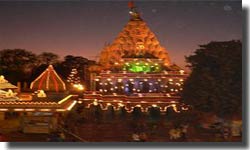
In the east this auspicious Kunda is a large-sized Veranda in which there is the entrance to the path leading to the garbhagrha. While in the northern side of the verandah in the cell there are the images of Sri Rama and Goddess Avantika which are worshipped. In the southern side of the main shrine, there exists many small Saivite temples built during the Shinde regime, among these the temple of Vrenda Mahakalesvara, Anadi Kalpesvara and Saptarshi are prominent and are remarkable pieces of architecture.
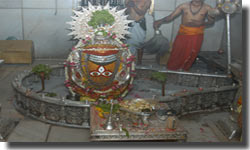
Time to Visit
The Puja-archana, abhisheka, arati and other rituals concerned are regulalrly performed all the year round in Mahakala temple. There are certain particular aspects of puja like the following:
Nitya Yatra
A Yatra which is to be conducted is narrated in the Avanti Khanda of the Skanada Purana. During this Yatra, after taking bath in the holy Sipra, the Yatri (Participator) respectively visits Nagachandresvara, Kotesvara, and Mahakalesvara, Goddess Avanatika, Goddess Harasiddhi and Agastyesvara for darsana.
Sawari (Procession)
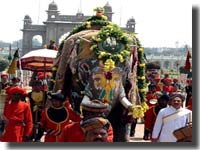
The last Sawari during Bhadrapada is been celebrated with great pomp and show and draws attendance of lakhs of devotees. And the procession of Lord Mahakala on Vijaydasami festival and the huge celebration at Dashahara Maidan is also very attractive.
Harihara Milana
On the day of Vaikuntha Chaturdasi, Lord Mahakala visits Mandir in a procession to meet Lord Dwarakadhisa (hari) usually during the mid-night. Later then in a similar procession on that very night Dwarakadhisa visits Mahakal temple. This festival is the symbol of one-ness between the two great Lords.
Rituals of the temple
One of the rituals performed in this temple is the Bhasm Arti that involves smearing the linga with hot ashes from the burning ghats (cremation grounds). Shiva is believed to dwell in cremation grounds, and the ash-smearing ceremony is a homage to the Destroyer of the Universe himself.
| This form of worship is symbolic of Death and Life being inseparable, an idea that is inherent to most of the Hindu schools of thought. The idol of MahakaleshwarTemple is also known as the Dakshinamurti as it faces the south (dakshin: south and murti: idol). | Nearby tourist places to Mahakaleshwar Temple
Indore Orchha Ujjain |
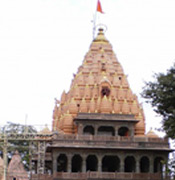 |
How to reach the Temple
- Through Air - the Nearest airport is Indore (53 K.m.) the Flights arrive here from Mumbai, Delhi, Ahmedabad, and Gwalior.
- Through Railways - Through railways the city of Ujjain is directly connected by railway line to Ahmedabad, Rajkot, Mumbai, Fouzabad, Lucknow, Dehradun, Delhi, Banaras, Kochi, Chennai, Bangalore, Hyderabad, Jaipur, Howrah and many more important cities of India.
- By Road - Ujjain is directly connected by road to Indore, Surat, Gwaliar, Pune, Mumbai, Ahmedabad, Jaipur, Udaypur, Nasik, Mathura.



